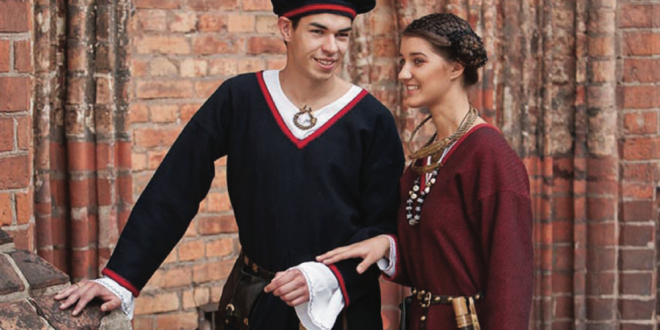By Daiva Steponavičienė.
In 2009 we celebrated the 1000 year anniversary of the first mention of Lithuania in a written historical document. As part of the festivities, an array of reconstructed national outfits worn by Lithuanian tribes in the 1st – 12th centuries and during the period of the Grand Duchy of Lithuania (GDL) in the 12th –16th centuries was on display during the World Lithuanian Song Festival. In creating this collection, I sought to demonstrate how the style of clothing of persons living in Lithuanian territory evolved over time.
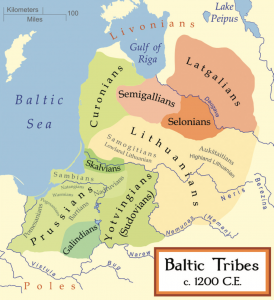
The clothing worn by ancient Balts can be grouped into 3 early periods: 1st – 4th centuries, before the formation of Baltic tribes; 5th – 8th centuries, the middle Iron Age, a period of tribe formation and migration, and the 9th – 12/13th centuries, the Late Iron Age, also known as the Viking era. These were followed by 3 later periods: the 13th – 14th centuries, when Lithuania was forming as a nation and was being influenced by the Slavic Byzantium; the 15th century, a period of growing Western influence and Gothic style, and finally, the 16th century, the so-called golden era of the Grand Duchy of Lithuania, when the country was influenced by the styles of the European Renaissance.
In the earliest of the above periods, six distinct cultural territories can be defined based on type of burial and grave intentories: northern, eastern, western, and central Lithuania, and the lower Nemunas River and Suvalki regions. By the beginning of the 5th century there were 10 tribes of Balts living in the Lithuanian region. These included the Yotvingians (Sudovians) to the south and Lithuanians in the southeast, divided into Highlanders (Aukštaitians) in the eastern part of Lithuania and Lowlanders (Samogitians) to the west. Skalvians lived in the southwest and Prussians lived on the shores of the Baltic Sea; Galindians were a bit to the east, between the Prussians and Yotvingians; Couronians occupied the western Baltic seashore further north, Semigallians and Selonians lived in the northern regions of Lithuania and the southern regions of Latvia, and Latgalians resided in what is now eastern Latvia (see map).
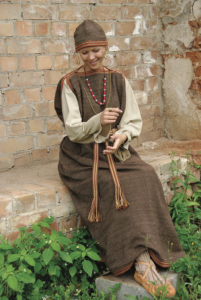
How did the apparel worn by the ancient peoples of our nation change over time? How did the clothing of one tribe differ from that of the others? Archaeological material from gravesites provides only limited information regarding the silhouette of the garment or the cut of the cloth in which a person was buried. However, the arrangement of ornaments in a grave, as well as test results done on existing small textile remnants can give us some clues.
Early Iron Age (I–IV centuries AD)
Clothing is believed to be of a tunic style. Tablet-woven sashes with simple, longitudinal designs are worn, tied at the waist or to embellish the garment edges. The cloth is woolen, woven on vertical frame looms in a 3-shaft twill pattern. Women’s headwear is embellished with small, round or flat metal pieces, their fronts adorned with ornaments hung on twisted, two-stranded wire. Another special type of women’s headwear from this period covers the temples with a symmetrical pair of flat, ring or coil shaped ornaments. We still do not know if this jewelry was worn for specific occasions. The metal ornaments from the period are subtle in form, made of silver filigree, with incrustations of azure blue glass and framed in red, black or green enamel.
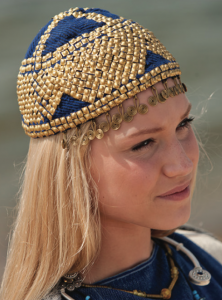
In the later part of this period, these types of ornaments, as well as elaborate multicolored glass bead necklaces brought from the Roman Empire, are no longer in evidence. The dominant technique for making ornaments becomes metal casting; decorative elements echo patterns found in tablet-woven sashes: longitudinal designs made up of dots, triangles, or series of open circles. Designs on brooches consist primarily of arched ladders. Long needle-like pins worn by women are bobbin shaped, or less commonly they have rounded blue ends, worn in pairs, joined together with one or two small chains and pinned to the shoulder region. Ornaments worn around the neck have trumpet or cone-shaped ends, often with azure blue dangles. Bracelets are massive and cut from a round piece of metal, or less commonly, made from braided pieces of metal. During this period both men and women wear such arm decorations, usually one on each wrist. Bracelets made of braided metal are especially popular.
Middle Iron Age (V–VIII centuries AD)
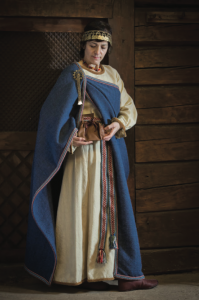
The clothing style as well as the cloth worn during the Middle Iron Age remains much the same as before: the woolen cloth is still woven on upright frame looms, and sashes have the same linear patterns. The metal ornaments, however, are not as subtle in style as before. They are much larger and the bodies of many of the pins and brooches are made of bronze and covered with a thin layer of silver; minimizing the amount of precious metal used.
During this period women begin wearing skull caps – a few rows of short woven decorative elements, interspersed with cast flat metal pieces, decorated with metal eyelets and strung together on woolen thread. Bracelets are still massive, with only the portion encircling the wrist being somewhat narrowed, their ends are now wider. Women wear one or two on each arm, while men adopt the habit of wearing one very large bracelent on the left wrist. This is the so-called “warrior” bracelet, intended to protect the wrist when holding a battle shield.
Necklaces made of glass beads are typically worn only by women, although men of the Aukštaičiai tribe also wear such neck ornaments. Both men and women wear amulets made of amber – typically a large bead, cone-shaped at both ends, that was hung from a brooch, sash, or woman’s straight pin. As before, needle-type pins are worn in pairs, connected with small chains and decorated with small hanging ornaments. In the northern regions these are a woman’s primary accessory clothing element; brooches, such as those worn by men, are not found with their clothes.
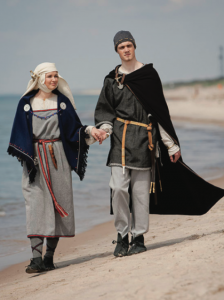
(photo by A. Moisiejenko)
The women of the southern Baltic tribes use brooches to fasten their clothing. These are circular in shape, cast in bronze or silver, and often decorated with serpent head motifs, or sometimes with poppy seed pods. Men wear leather belts with raised metal clasps, and sashes from which they hang their weapons, and tall boots fastened at the knee with belt buckles.
Late Iron Age (IX–XIII centuries AD)
During the Late Iron Age the ornamentation of the clothing worn (and, we believe, the clothing silhouette itself) changes. Brooches now have a horseshoe shape rather than the earlier circular shape. We find some of them in men’s graves, leading us to surmise that men’s clothing from the period was cut down the center and that the brooches were used as buttons. The tablet-woven sashes now have more complicated patterns of geometric rhombi, and cross and swastika motifs.
Along with woolen cloth, beginning with the 10th century, we now find cloth made of linen. The larger quantity of woven material leads us to believe, that towards the end of this period, the Balts, like other European peoples, have now learned to use horizontal looms. With the advent of flax cultivation, we begin to see the use of thread made of a wool/flax combination in woven sashes and later, in scarves.
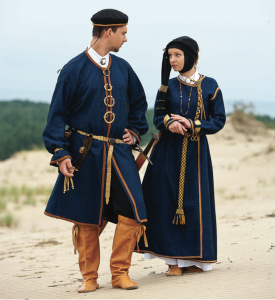
As before, women enjoy wearing knotted skull caps, although now their small metal ornaments are no longer cast, but rather hammered into various shapes and embellished with intertwined ellipses, swastikas, triangles and rhombi. These pieces are strung on braided or spun linen thread rather than on strands of wool. Bracelets are mostly of braided metal. Men continue wearing a massive bracelet on their left wrist, but now these are wrapped in a long woven sash and strung with small rings (chainmail). The Semigallian wimples are adorned similarly with small chains strung together on a long string, as are Samogitian womens’ hats/headwear. Maple tree whirligig-shaped ornaments hang from their fronts.
Clothing often is embellished with tiny round metal beads, a style especially favored by Semigallians. Samogitian women string and hang beads in a flat rhombus shape on their robes, so that as they move, the beads touch each other and make a tinkling sound. Selonian women like to pin tubular bronze pins on their robes to form various geometric designs; the tunics of the Latgalian men are similarly adorned.
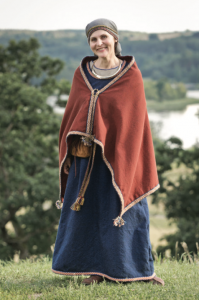
Important parts of the “dress uniform” of warriors/soldiers are tall boots and a leather belt covered with hammered bronze plates ending in woven bronze tassels. During this period neck ornaments are made of braided metal with loop and hook closures. Those worn by Selonian women have flat, curved ends decorated with geometric motifs; some have additional flat metal pieces or small round bangles arranged in a trapeze shape. Often these bangles are used to form a part of womens’ necklaces along with braided elements and glass beads. As before, bracelets are mostly of braided metal, although their central portions are widened and geometric forms added.
XIII–IV centuries AD
The changes in outfits worn during the 13th – 14th centuries are even greater. Along with the traditional and locally made garments of linen and wool, we now find imported weaves of silk and brocade. Because of their expense, these materials are used only in sashes and textile-based headwear. Plaid scarves can now be found. Headwear has also changed; now it is made of sashes of wool or silk and decorated with small, four or five-sided flat plates; spaces between them are filled with threaded bead embroidery (biserio).
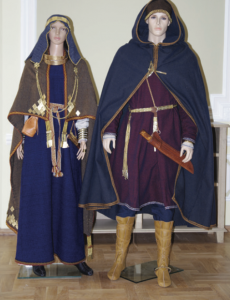
(photo by Ramunė Steponavičiūtė)
The shape of brooches changes, such that now we find round, cast brooches with a hole in their center used for fastening. Small horseshoe-shaped brooches are found arranged vertically on the right side of the neck, most likely having been used to fasten the opening of a dress or underclothes. Bracelets are uncommon and the ones found are now of a different shape – in the form of bands made from pieces of bent, decorated sheets of metal, or tripartite and joined with loops.
Necklaces are made from small glass beads, with rounded, four-sided, or cross-shaped dangles and seashells. Earrings are a new accessory and are worn primarily by Balt women, who also begin to wear metal-plated belts of the type that men wear, as well as a new “invention” from the West – leather pouches with closures attached to their belts. Also worn are amulets – claws of male bears encased in bronze, and cast bronze keys with rhombus-shaped tops in a gothic style.
The men’s outfits of this period are much harder to determine from the available archaeological material. Nevertheless, we can deduce that men wear woolen socks and tall boots, and linen underclothes. They sport wool tunics woven on a three shaft loom, with their garments held together with bronze plated belts from which would hang a leather pouch and knife.
Closing thoughts:
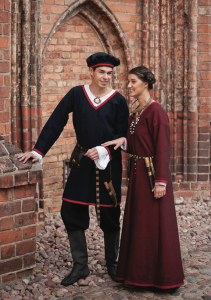
In evaluating the features of Baltic clothing particular to a given time period, a fair question arises – which portions of these outfits can be inferred from archaeologic evidence? Archaeological material gives only partial information. Nevertheless, by viewing the way material found in gravesites was laid out, we can form a certain picture of the clothing that was worn and make artful and empiric reconstructions.
Over the centuries, the outfits worn by the Balts required the work of various craftsmen to produce, as different elements were made from wool, bronze or silver, iron, and leather. Similarly, the project to make historical recreations of these outfits could not have been accomplished without the help of several textile artists (a weaver, a tablet weaver, a knitter, a seamstress), jewelry crafters – one familiar with metal casting, another specializing in metal shaping, as well as a blacksmith, a leather worker, and a shoemaker. First and foremost, it was necessary to gather available historical data, and only then could the reconstruction of the outfits shown be accomplished in as realistic a fashion as possible.
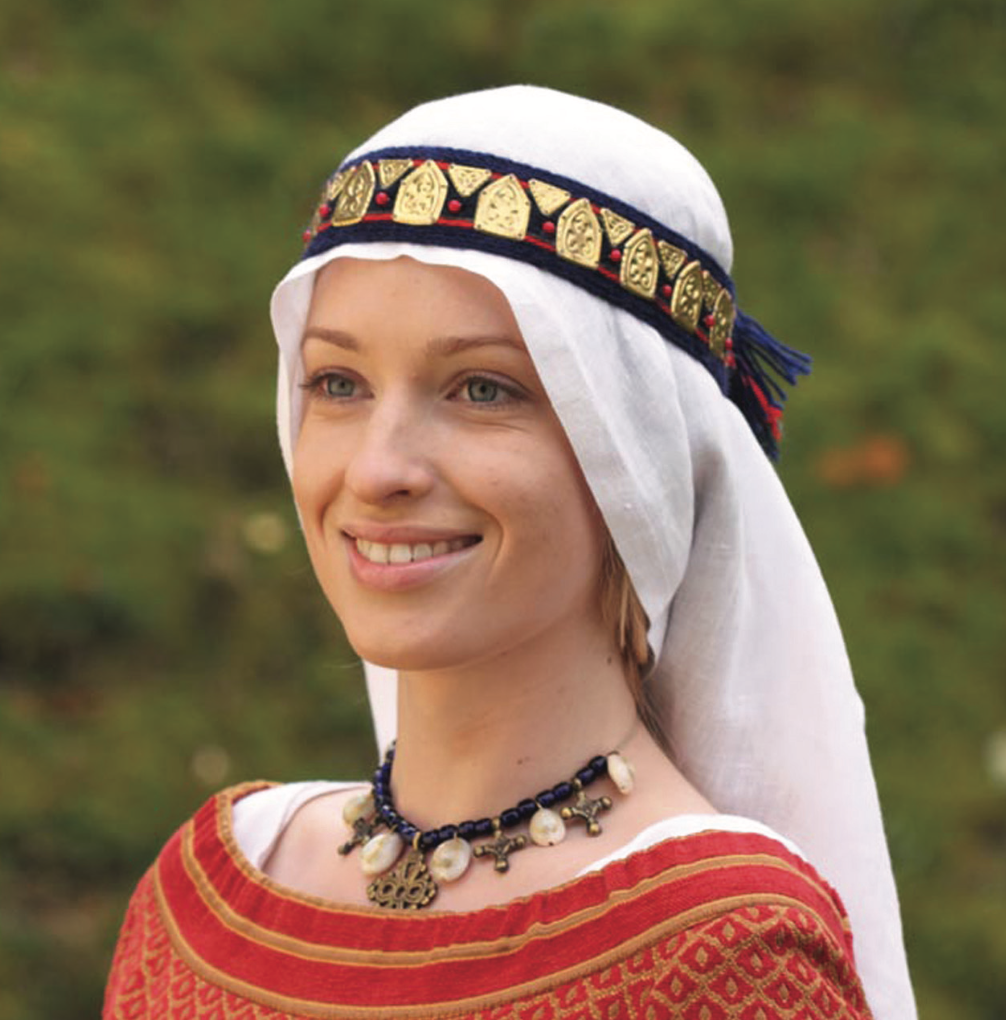
 DRAUGAS NEWS Lithuanian World Wide News in English
DRAUGAS NEWS Lithuanian World Wide News in English
